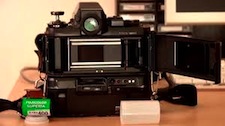It’s the time of year for saving money!

Last week I bought a new old camera. Actually, I acquired a camera and a motor drive that I have no intention of ever putting a roll of film through it. I bought a road-worn Nikon F3 high-eye-point body with an MD-4 motor drive purely because it’s a wonderful piece of mechanical engineering. I loved my pair of Nikon F3s the first time I owned them, back in the late 1970s. But I sold my F3s when I got Nikon FM and FE bodies – The reduction in size and weight was a delight and the quality of my photographs stayed the same.
The fact that I could buy several Nikon FM2s or FE2s for less than the price of a single Nikon F4 when the F3 was discontinued in 1988 made it so I never went back to the Nikon pro F series again. I found that the lighter, less robust, FM2, FE2, and even the plastic-bodied 8008 delivered the same image quality (after all they were using the same lenses) as the big Fs. The bottom line was that I didn’t need the extra robustness of an F3 to make photographs. Some audiophiles are coming to the same sort of conclusions when it comes to DACS.

Going back to camera bodies – no contemporary digital camera bodies are as robust or solidly built as their old analog forebears. Camera manufacturers realized that they no longer had to make a camera body that could last for ten or even five years of heavy usage because they would be replaced by a newer body long before usage would be an issue. My first digital camera, an Olympus E-10, was so robustly made that it was heavier than my last Nikon film camera. I still have the Olympus, it still works, but since my iPhone has a higher pixel count, the Olympus E-10 doesn’t see the outside of a camera bag much. Subsequent Olympus offerings haven’t been nearly as chunky because they don’t need to be. My latest digital camera body, the Panasonic G6, weighs way less than a pound, produces outstanding images, and via adapters can take all my old Nikon AI manual focus lenses. It’s designed to last maybe five years? But I expect I’ll replace it in less than three.
Due to the rapid pace of digital technological advancement, camera bodies no longer need to be built to last for 50 years, or even five years. I look at DACs the same way – they don’t need to be designed to last as long as a power amplifier, for instance, because their effective life is so much shorter than a power amplifier. The original Sony CD-101 was built to last a long time, and many still work, just like my Olympus E-10, and is virtually as obsolete. Both were overbuilt for their purposes.

The pace of digital audio innovation is such that very few audiophiles have or want to have a ten-year old DAC anymore than photographers want to use ten-year old digital cameras. Until there’s a sign that DACs have reached a technological plateau where the pace of innovation slows down, I see no reason to consider a DAC to be a long-term purchase.
Of course, there are always some exceptions, such as the Wyred4Sound DAC2, which were designed so that it could be upgraded with new boards as needed (hence the new DSD and SE). But since most DACs can expect a technological lifespan roughly equivalent to a digital camera, perhaps audiophiles should consider them disposable as well…





